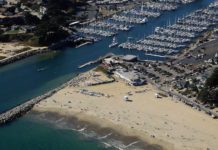
In May, Dr. William Mears spent a week in Haiti working eight-hour medical shifts from a mobile clinic. Even though half a year has passed since the quake that left 1 million people displaced, Mears said, the country is still in shambles.
“There’s been very little restoration work — there’s still a lot of rubble,” said Mears, a family physician at the Palo Alto Medical Foundation in Scotts Valley.
The visit was Mears’ fourth time in Haiti but his first since the Jan. 12 temblor that measured 7.0 on the Richter scale.
“It’s always chaotic in Haiti, even more so after the earthquake,” Mears said.
Mears traveled with a team of 14 from the medical center, made of up of three physicians, two medical students, two nurse practitioners and some registered nurses, on May 17.
The group traveled around the Haitian capital, Port-au-Prince, in a large bus, Mears said.
“We would basically stop at different sites and set up a mobile clinic outside the bus,” Mears said.
The average temperature was about 114 degrees, and the air is extremely humid, he said.
The group stopped at schools and orphanages to help the children there.
“There’s very little health care and food,” Mears said. “We saw malnourished children and people that had never seen a doctor in their life. I felt a deep sadness for all the children that were left orphaned by the quake.”
Mears and the team also visited tent cities, sprawling clusters of shelters that house thousands of displaced Haitians.
“There would be 10 people in one small tent,” Mears said.
Mears said the team focused mainly on acute care and the most urgent needs.
“There were lines and lines of people waiting to be seen,” he recalled. “Malaria was very common. So were skin infections. There were a lot of pregnant woman that had no prenatal care.”
Many people have asthma in Haiti from all the dust in the air, the doctor said. Post-traumatic stress disorder — from surviving the earthquake and dealing with the poor living conditions since — is also common.
“One of our teammates is a crisis worker,” Mears said. “Everybody lost someone. Everyone has been touched by loss. The Haitians are very resilient, but there is definitely an underlying sadness.”
The travelers used iPhones to create a digital charting system that kept track of who they would see, and solar panels powered some of their medical equipment.
Mears said being able to provide simple things made a surprisingly great difference.
“We brought a bunch of seeing-eyeglasses,” Mears said. “There was this elderly lady who could barely see, and we found her a pair that worked. Seeing her face after putting on the glasses was a great moment.”
Mears said the struggles he saw were a wakeup call, especially now that the aftermath of the earthquake in Haiti is no longer at the forefront of news headlines.
“My bottom line is for people not to forget about Haiti,” Mears said. “Walking through the tent cities and seeing how much hardship is going throughout the day…, there’s still a lot of work to be done.”
To comment, e-mail reporter Michelle Camerlingo at mi******@*********er.com, call 438-2500 or post a comment at www.pressbanner.com.












